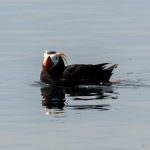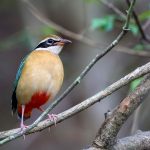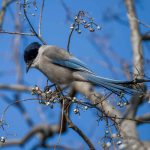 The first thing one notices about Pete Dunne’s Essential Field Guide Companion is its intimidating bulk. This massive tome, larger even than The Sibley Guide to Birds, is not likely to accompany any but the strongest-backed birders into the field. Next is the astonishing realization that, apart from the dust jacket, this book is devoid of pictures of birds. Not a photograph or illustration to be found, simply 710 pages of very small, very dense text. One might be moved to wonder, “Just what is Pete Dunne trying to accomplish with this colossal compendium?” If you are familiar with Dunne’s sterling reputation and body of work, the answer to that question should be obvious.
The first thing one notices about Pete Dunne’s Essential Field Guide Companion is its intimidating bulk. This massive tome, larger even than The Sibley Guide to Birds, is not likely to accompany any but the strongest-backed birders into the field. Next is the astonishing realization that, apart from the dust jacket, this book is devoid of pictures of birds. Not a photograph or illustration to be found, simply 710 pages of very small, very dense text. One might be moved to wonder, “Just what is Pete Dunne trying to accomplish with this colossal compendium?” If you are familiar with Dunne’s sterling reputation and body of work, the answer to that question should be obvious.
Pete Dunne is trying to make you a better birder.
Pete Dunne’s Essential Field Guide Companion: A Comprehensive Resource for Identifying North American Birds is not a field guide, nor is it meant to replace your current field guide. This publication is, as the title clearly suggests, a resource meant to operate in harmony with a field guide. Though the book was just published, its success in this endeavor seems assured, if only because it so brilliantly accomplishes what a field guide cannot.
A field guide focuses first and foremost on visual cues to avian identification. A good guide delivers concise detail on range, habitat, vocalizations, and distinctive behavior, but the emphasis always rests on a bird’s size, appearance, and specific field marks. This is to be expected; they don’t call it bird watching for nothing.
Dunne, one of the nation’s most prominent and accomplished birders, is a pioneer of the innovative “Cape May School of Birding.” This approach to avian identification concerns itself less with specific field marks and more with what is known as GISS. GISS (giss, gizz, jizz, etc.) can be considered the holistic impression of a species, one informed by the bird’s structure, shape, size, and manner. These factors and others are, the Cape May School asserts, more reliable than mere visual evidence.
Consider this atlas of avifauna the textbook for your first lessons at the Cape May School of Birding. Dunne has compiled painstaking profiles on an astonishing 691 species and subspecies, essentially every bird that breeds in North America or at least drops in occasionally. Unable to depend on illustrations to do the talking for him, the author paints a vivid picture of each subject by elaborating on a variety of elements. First, a bird’s Status, Distribution, Habitat, Cohabitants, and Movement/Migration provide its biographical backdrop, an insight into its probability at a given place in time. Probability lies at the crux of easy, accurate identification, which is indubitably why Dunne has made it one of the cornerstones of this approach. Next, the bird’s Size and Overall Shape, Structural Characteristics, and Plumage, breeding and non-breeding, are detailed. This description is supported by insight into Behavior, Flight, and, of course, Vocalizations. Last but not least, Dunne offers up Pertinent Particulars in those entries where he can proffer something particularly pertinent. He also tags each species with a nickname, some complimentary or incisive, others hilarious or just plain silly.
What is the effect of this flood of information? The desired outcome is a fuller, more nuanced understanding of each species, one that will catalyze ready identification of an unknown bird. The actual outcome seems to hit that ambitious mark. Now matter how fantastic your favorite field guide is, it still presents, at best, an incomplete depiction of each subject. Furthermore, because of the design philosophy behind these guides, they cannot help but perpetuate a predominantly visual approach to avian identification. Dunne’s Field Guide Companion rounds out a bird’s biography by providing insight that goes much deeper than plumage and range. Armed with both resources, a bird watcher’s life will suddenly become a lot less frustrating. The day I stop learning from Pete Dunne’s Essential Field Guide Companion: A Comprehensive Resource for Identifying North American Birds will have to be the day I’ve attained the encyclopedic mastery of American avifauna that the author so abundantly exhibits. Were such a miracle to ever occur for me or any other new pupil of the Cape May School of Birding, I’m sure Pete Dunne would be thrilled.











Leave a Comment